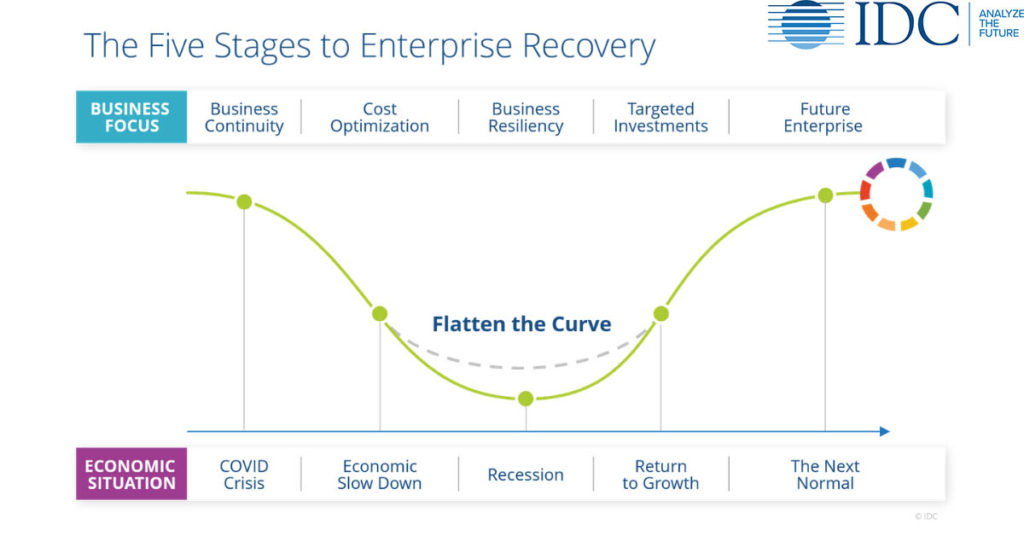The COVID-19 pandemic has disrupted business operations across a broad swath of the economy and left both buyers and sellers reeling. IDC’s modeling of this crisis, The Five Stages to Enterprise Recovery, breaks down how companies are responding into the five phases shown below.

For IT sellers, this model provides a way of understanding how buyers are in very different places than they were just six months ago. More importantly, it articulates how buyers have different needs (i.e., business focus) based on where they—and the industries within which they operate—are along this curve. It’s crucial to understand the impact each stage has on buyers within your target markets in order to equip your sellers with the timely insights they need to be successful.
Enterprise Recovery – Where Are You?
Equipped with this knowledge, they can adapt their buyer engagement strategy to provide options and guidance tuned to the different stages, along with a clear articulation of how these options help solve the problems associated with that point in the curve. At this point, most companies have moved beyond the first phase and are either in the second or third stage of this model with a focus on Cost Optimization and the building of Business Resiliency.
Buyers in the Cost Optimization stage are deciding what investments they can delay in the face of uncertain revenues and striving to operate as efficiently as possible. On one hand, this makes it difficult to get them to explore new options—indeed, tech vendors will serve their customers well and earn their loyalty by helping them make the most of existing investments.
On the other hand, this stage presents the opportunity to provide options for reducing costs. Cloud and other solutions that provide scale and the flexibility to adapt to changing business needs without major investments are likely to fall on receptive ears. To get the best hearing, selling points should speak to an offering’s business value and the specific outcomes it can produce that improve operational efficiencies and help reduce costs.
How to Move Forward in Your Enterprise Recovery Journey
The trials companies face extend beyond the immediate downturn because the COVID-19 crisis and other societal issues have ripple effects. The resulting disruptions are complex, layered, and vary by organization size, industry, and location. With this in mind, companies need to prepare for ongoing threats to their business by developing their Business Resiliency. As shown in the diagram above, this is the primary means by which they can “Flatten the Curve” of crisis-driven recessionary impact.
A prime example is the need to accommodate shifts in how and where employees do their jobs. Work-from-home is likely to be an area of ongoing demand and companies will need to make the investments necessary for this work to be productive. Any important service on which the business depends must be enabled for remote work with an eye toward maintaining collaboration while working remotely. This same thinking, applied to virtually engaging and supporting customers, can also provide resiliency in this important area. Finally, reopening offices will require rethinking policies and processes—along with the attendant technology support—needed to provide a safe work environment.
All this demonstrates that the digital transformation on which forward-thinking companies have been working should not slow down, but instead needs to be accelerated. By anticipating future network and service access needs, shifting some workloads to the cloud, and enabling business to be conducted digitally, IT professionals will be able to accommodate changing employee and customer needs with minimal disruption to business productivity. With this context in mind, here are three things you can do to make use of IDC’s Five Stages to Enterprise Recovery model:
- First, you must tie your offerings to how they enhance the IT buyer’s ability to operate more efficiently and be more resilient in the face of ongoing threats to their business. This narrative needs to be elevated from the traditional selling of features and benefits, to a more outcome-focused approach that speaks to these needs. You must answer the question, “How does your offering help the client achieve their objective of improved efficiencies and greater resilience?” This is the new normal to which sellers must speak—whatever your old pitch was, it’s no longer relevant.
- Second, you need to make sure your engagement strategy is touching all the right points of contact in this new landscape. IT contacts with whom your sellers have been predominantly working in the past may be locked into shrinking budgets. As such, you’ll need to engage those stakeholders who can be receptive to this message—in particular, the CFO and other business executives charged with the overall health of the business. This demands they be equipped with a strong articulation of the business value and the ROI of your offerings.
- Third, how you sell needs to change. “Getting a meeting” might no longer be possible for your salespeople. As such, you need to enable them with a solid set of marketing, lead generation, and selling tools that support virtual selling. This includes not only virtual meeting applications, but sales enablement assets that speak to the issues we’ve outlined above. These should be compelling, interactive, and easy to understand so that buyers are engaged immediately and instilled with a desire to keep the dialog going. Most importantly, these tools must enable the seller to articulate a relevant, customized value proposition and, ideally, close business digitally.
By establishing your value to customers, especially in these early stages of recovery, you will position yourself as the “Trusted Advisor” when they fully return to investing in digital transformation.
Read “Moving From Crisis to Recovery: Why Tech is Critical to Success” to further explore the 5 stages of enterprise recovery and see how technology will play an integral part of moving through crisis to recovery.
Join us on Tuesday, August 11 at 12pm ET to further delve into the five stages of enterprise recovery with IDC’s webinar, ” The Five Stages to Enterprise Recovery and Selling in the Next Normal”:




